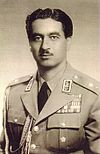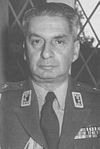SAVAK
| سازمان اطلاعات و امنیت کشور | |
 | |
| Agency overview | |
|---|---|
| Formed | 20 March 1957 |
| Dissolved | 12 February 1979 |
| Superseding agency | |
| Headquarters | Tehran |
| Employees | 5,000 at peak[1] |
| Agency executives |
|
SAVAK (
SAVAK had 5,000 agents at its peak.[1] Gholam Reza Afkhami estimates SAVAK staffing at between 4,000 and 6,000.[3] Time magazine's 19 February 1979 publication also states that it had 5,000 members.[4]
History
1957–1971
After the
A U.S. Army colonel working for the CIA was sent to Persia in September 1953 to work with General
In March 1955, the Army colonel was "replaced with a more permanent team of five career
SAVAK had the power to censor the media, screen applicants for government jobs, and "according to reliable Western source,
In 1961 the Iranian authorities dismissed the agency's first director, General Teymur Bakhtiar,[12] and he later became a political dissident. In 1970, SAVAK agents assassinated him, disguising the deed as an accident.
Pakravan was replaced in 1966 by General Nematollah Nassiri, a close associate of the Shah, and the service was reorganized and became increasingly active in the face of rising leftist and Islamist militancy and political unrest.
Siahkal attack and after
A turning point in SAVAK's reputation for ruthless brutality was reportedly an
Abrahamian estimates that SAVAK (and other police and military) killed 368
One well known writer was arrested, tortured for months, and finally placed before television cameras to 'confess' that his works paid too much attention to social problems and not enough to the great achievements of the White Revolution. By the end of 1975, twenty-two prominent poets, novelist, professors, theater directors, and film makers were in jail for criticizing the regime. And many others had been physically attacked for refusing to cooperate with the authorities.[19]
The repression was softened thanks to publicity and scrutiny by "numerous international organizations and foreign newspapers." Jimmy Carter became President of the United States and he raised the issue of human rights in the Imperial State of Iran. Overnight prison conditions changed. Inmates dubbed this the dawn of "jimmykrasy".[20]
Directors
| No. | Portrait | Director | Took office | Left office | Time in office |
|---|---|---|---|---|---|
| 1 | Timsar Teymur Bakhtiar (1914–1970) | 1957 | 1961 | 3–4 years | |
| 2 | Timsar Hassan Pakravan (1911–1979) | 1961 | 1965 | 3–4 years | |
| 3 | Timsar Nematollah Nassiri (1911–1979) | 1965 | 1978 | 12–13 years | |
| 4 | Timsar Nasser Moghaddam (1921–1979) | 1978 | 1979 | 0–1 years |
Number of employees
Over the years, the question of the number of employees of SAVAK has been the subject of debate by many historians and researchers. Given the fact that Iran has never disclosed data on the number of employees of the secret agency - many historians gave conflicting figures for the number of SAVAK personnel - 6,000,[21] 20,000,[22] 30,000 and 60,000.[23]
In one of his interviews, on February 4, 1974, the Shah stated that he did not know the exact number of employees of SAVAK. However, he estimated their total number to be less than 2,000 employees.[24] To the frequently asked question about “torture and atrocities” in SAVAK, the shah answered negatively, designating newspaper reports about the “arbitrariness and cruelty of SAVAK” as a lie and slander.[25] Leaflets circulated after the Islamic Revolution indicated that 15,000 Iranians officially served in SAVAK, not to mention the many unofficial employees.
Operations
During the height of its power, SAVAK had virtually unlimited powers. It operated its own detention centers, such as Evin Prison. In addition to domestic security, the service's tasks extended to the surveillance of Iranians abroad, notably in the United States, France, and the United Kingdom, and especially students on government stipends. The agency also closely collaborated with the CIA by sending their agents to an air force base in New York to share and discuss interrogation tactics.[26]
Teymur Bakhtiar was assassinated by SAVAK agents in 1970,[27] and Mansur Rafizadeh, SAVAK's United States director during the 1970s, reported that General Nassiri's phone was tapped.[28] Mansur Rafizadeh later wrote of his life as a SAVAK man and detailed the human rights violations of the Shah in his book Witness: From the Shah to the Secret Arms Deal: An Insider's Account of U.S. Involvement in Iran. Mansur Rafizadeh was suspected to have been a double agent also working for the CIA.[29]
SAVAK was additionally involved in the 1975 Panjshir Valley uprising in the Republic of Afghanistan, in collaboration with the CIA and the Pakistani ISI.[30][31]
According to Polish author Ryszard Kapuściński, SAVAK was responsible for: Censorship of press, books, and films; Interrogation and often torture of prisoners; and Surveillance of political opponents.[32]
Victims
Writing at the time of the Shah's overthrow, Time magazine on February 19, 1979, described SAVAK as having "long been Iran's most hated and feared institution" which had "tortured and murdered thousands of the Shah's opponents."[4] The Federation of American Scientists also found it guilty of "the torture and execution of thousands of political prisoners" and symbolizing "the Shah's rule from 1963–79." The FAS list of SAVAK torture methods included "electric shock, whipping, beating, inserting broken glass and pouring boiling water into the rectum, tying weights to the testicles, and the extraction of teeth and nails."[33][34]
Fardoust and security and intelligence after the revolution
SAVAK was closed down shortly before the overthrow of the monarchy and the coming to power of Ayatollah Ruhollah Khomeini in the February 1979 Iranian Revolution. Following the departure of the Shah in January 1979, SAVAK's more 3,000 strong central staff and its agents were targeted for reprisals. However, it is believed that Khomeini may have changed his mind and may have retained them into the new SAVAMA.[35] Hossein Fardoust, a former classmate of the Shah, was a deputy director of SAVAK until he was appointed head of the Imperial Inspectorate, also known as the Special Intelligence Bureau, to watch over high-level government officials, including SAVAK directors. Fardoust later switched sides during the revolution and managed to salvage the bulk of the SAVAK organization.[36] According to author Charles Kurzman, SAVAK was never dismantled but rather changed its name and leadership and continued on with the same codes of operation, and a relatively unchanged "staff."[37][38]
SAVAK was replaced by the "much larger"[39] SAVAMA, Sazman-e Ettela'at va Amniat-e Melli-e Iran, also known as the Ministry of Intelligence and National Security of Iran.[40] After the Iranian Revolution, a museum was opened in the former Towhid Prison in central Tehran called "Ebrat". The museum displays and exhibits the documented atrocities of SAVAK.
See also
- Second Bureau of Imperial Iranian Army
- Prime Ministry Intelligence Office
- Ministry of Intelligence (Iran)
- Basij
References
- ^ ISBN 0805098976, p. 231
- ^ Department Of State. The Office of Electronic Information, Bureau of Public Affairs. "Summary". 2001-2009.state.gov.
- ISBN 978-0-520-25328-5), p. 386.
- ^ a b SAVAK: "Like the CIA". Feb. 19, 1979 Archived 2009-06-21 at the Wayback Machine.
- Nikki R. Keddie and Yann Richard, Modern Iran: Roots and Results of Revolution Archived 2014-07-26 at the Wayback Machine(Yale University Press, 2006), p. 134.
- ^ M. J. Gasiorowski, eds., Neither East Nor West. Iran, the United States, and the Soviet Union, New Haven, 1990, pp. 148–51
- ^ Encyclopaedia Iranica. Retrieved 26 July 2008.
- ^ N. R. Keddie and M. J. Gasiorowski, eds., Neither East Nor West: Iran, the United States, and the Soviet Union (New Haven, 1990), pp. 154–55; personal interviews.
- ^ Profile: Norman Schwarzkopf Sr. Archived 2011-04-22 at the Wayback Machine History Commons
- ^ New York Times, 21 September 1972.
- ^ a b Ervand Abrahamian, Iran Between Two Revolutions, p. 437
- ^ a b "National security". Pars Times. Archived from the original on 2013-05-15. Retrieved 24 August 2013.
- ^ Harvard Iranian Oral History Project Archived 2008-02-29 at the Wayback Machine Transcript of interview with Fatemeh Pakravan conducted by Habib Ladjevardi 3 March 1983.
- ^ Momen, Moojan, An Introduction to Shi'i Islam (Yale University Press, 1985), p. 255.
- ^ Bill, James A., Tragedy of American-Iranian Relations Archived 2016-05-18 at the Wayback Machine(Yale University Press, 1989), p. 181–82
- ^ Ervand Abrahamian, Tortured Confessions (University of California Press, 1999), p. 106.
- ^ Abrahamian, Tortured Confessions, p. 106.
- ^ Abrahamian, Tortured Confessions, pp. 103, 169.
- ^ Abrahamian, Iran Between Two Revolutions, pp. 442–43.
- ^ Abrahamian, Tortured Confessions, p. 119.
- ^ Sullivan, William H., Mission to Iran, New York: W. W. Norton & Company, 1981, pp. 96–97.
- ^ Sullivan, William H., Mission to Iran, New York: W. W. Norton & Company, (1981), p. 97.
- ^ Graham, Robert, Iran: The Illusion of Power, New York: St. Martin’s Press, (1978), p. 146.
- ^ Gérard de Villiers: Der Schah. (1976), Seite 396 und 410.
- ^ Gérard de Villiers: Der Schah. (1976), Seite 408.
- ^ Fisk. Great War for Civilisation, p. 112.
- ^ Reeva S. Simon, Philip Mattar, Richard W. Bulliet. Encyclopedia of the Modern Middle East: A-C. Macmillan Reference USA, (1996), p. 294.
- ^ Rodney Carlisle. "Encyclopedia of Intelligence and Counterintelligence". (2005), p. 325.
- ^ Henry Robinson Luce. "Time", Volume 129. Time Incorporated, (1987), p. 327.
- ISBN 978-1-5035-7300-0.
- ^ https://www.brookings.edu/wp-content/uploads/2016/07/Chapter-1-3.pdf
- ^ Kapuściński, Ryszard, Shah of Shahs, pp. 46, 50, 76
- ^ Ministry of Security SAVAK Archived 2012-10-04 at the Wayback Machine, Federation of American Scientists.
- ISBN 978-1592571413.
- ^ "Khomeini is Reported to Have a SAVAK of His Own - the Washington Post". The Washington Post. Archived from the original on 2017-03-15. Retrieved 2017-02-26.
{{cite news}}: CS1 maint: bot: original URL status unknown (link) - ^ Robert Dreyfuss, Hostage to Khomeini 1981 and The Devils Game: How the United States Unleashed Fundamentalist Islam, 2004
- ^ Intelligence (international relations) : Iran Archived 2008-10-13 at the Wayback Machine. (2008). In Encyclopædia Britannica. Retrieved July 26, 2008.
- ^ Charles Kurzman, The Unthinkable Revolution (Harvard University Press), p. ?
- ^ Abrahamian, History of Modern Iran, (2008), p. 176
- ^ The ministry is also referred to as VEVAK, Vezarat-e Ettela'at va Amniat-e Keshvar, though Iranians and the Iranian press never employ this term, using instead the official Ministry title.[citation needed]
External links
- Ministry of Intelligence and Security VEVAK – Iran Intelligence Agencies at website of Federation of American Scientists





